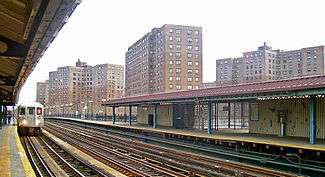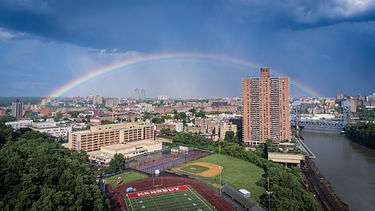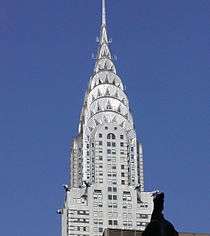Marble Hill, Manhattan
| Marble Hill | |
|---|---|
| Neighborhood of Manhattan | |
|
A rainbow over Marble Hill, seen from the west | |
 Marble Hill  Marble Hill  Marble Hill Location in New York City | |
| Coordinates: 40°52′34″N 73°54′40″W / 40.87611°N 73.91111°WCoordinates: 40°52′34″N 73°54′40″W / 40.87611°N 73.91111°W | |
| Country |
|
| State |
|
| City |
|
| Borough | Manhattan |
| Founded | 1891 |
| Named for | Local deposits of dolomite marble quarried for Federal buildings in lower Manhattan when New York was the Capital of the United States in the 1780s. |
| Area[1] | |
| • Total | 0.38 km2 (0.145 sq mi) |
| Population (2010)[1][2] | |
| • Total | 9,481 |
| • Density | 25,000/km2 (65,000/sq mi) |
| Economics[1][2] | |
| • Median income | $44,096 |
| ZIP code | 10463 |
| Area code | 718, 347, and 646 |

_-_re-tinted_Marble_Hill_detail.png)
Marble Hill is the northernmost neighborhood in the New York City borough of Manhattan, and the only Manhattan neighborhood on the mainland of North America.
Politically a part of Manhattan and New York County, Marble Hill became an island in the Harlem River when it was separated from the island of Manhattan by the construction of the Harlem Ship Canal in 1895. In 1914, the Harlem River was filled in on the north side of Marble Hill, connecting it to the North American mainland and the Bronx.[3] Because of this change in geography, Marble Hill is often associated with the Bronx and is part of two of the latter's Community Board Districts.
Broadway is the neighborhood's primary thoroughfare.
History
Colonization
Marble Hill has been occupied since the Dutch colonial period. On August 18, 1646, Governor Willem Kieft, the Dutch Director of New Netherland, signed a land grant to Mattius Jansen van Keulan and Huyck Aertsen. This grant had comprised the whole of the present community. Johannes Verveelen petitioned the Harlem authorities to move his ferry from what is now the East River and 125th Street to Spuyten Duyvil Creek because the creek was shallow enough to wade across, thus providing a means of evading the toll. The ferry charter was granted in 1669.
Within Marble Hill, Teunissen Place was named for Tobias Teunissen, a wool washer from Leyden, Holland, who came to the area in 1636. He applied for and received a land grant to live in Inwood near 213th Street. Occasionally he had worked on the De La Montagne farm, which was located in what is now the Harlem section of Manhattan. Teunissen was killed in an Indian raid in 1655, and his wife and child were held hostage until they were ransomed by the Dutch authorities. The Dyckmans and the Nagles, who owned land in Inwood, purchased the Teunissen property in 1677.
Two bridges connected Marble Hill with the mainland. These were the King's Bridge, constructed in 1693 by Frederick Philipse, and the Dyckman Bridge, constructed in 1759 by Jacobus Dyckman and Benjamin Palmer. The King's Bridge was built across Spuyten Duyvil Creek as a toll bridge under Royal Charter for Frederick Philipse. The Dyckman Bridge was constructed as a toll-free bridge for the farmers who refused to pay the toll. Both bridges have been covered over with landfill. At 210 West 230th Street on the southwest corner of Broadway and 230th is a plaque designating the area as the site of the King's Bridge. The site of the Dyckman Free Bridge is located on the grounds of today's Marble Hill Houses.
One of the local visiting spots during this period was a tavern operated by the Dyckman family. They had a tavern called the Black Horse Inn, located just south of McGowan's Pass in what is now East Drive of Central Park, near 102nd Street.[4] The Dyckmans sold the Black Horse to finance a new operation on the west side of Broadway and 226th Street that was to be managed by Benjamin Palmer, who owned property on City Island. It was situated to cater to the traffic from both bridges. In 1772 the Dyckmans sold the tavern to Caleb Hyatt and was known by the new owner’s name as Hyatt’s Tavern at the Free Bridge.
During and after the American Revolution
When hostilities broke out at the start of the American Revolution, the Continental Army constructed a fort on Marble Hill as part of a series of forts to defend the area. By November 1776, the fort had been taken over by Hessian forces and renamed Fort Prince Charles in honor of Charles, Duke of Brunswick, brother-in-law to George III. Despite contrary beliefs, the King's Bridge and the Dyckman Free Bridge served as escape routes for the retreating American forces after the Battle of Fort Washington on November 16, 1776. In January 1777, an American attack was made in the Marble Hill area against the Hessian occupiers. This particular raid was under the command of General William Heath, which, when the cannons opened up, forced the Hessians to retreat from the tavern to the fort to return fire.
After the war ended, the tavern remained in the Hyatt family until 1807, when it was leased to James Devoe. The building was eventually razed and its successor was the Kingsbridge Hotel, which was located on the east side of Broadway and 226th Street. The hotel had a mansard roof and a central turret. It catered to the anglers and sportsman who came to the area either by the Hudson River Railroad Company or boat service up the Harlem River. One of the meals served at the hotel was turtle dinner, which became a favorite of the guests. The hotel’s business declined when Broadway was widened and interest was lost in the community. The hotel eventually fell into disrepair and was torn down in 1917.
In 1817 Curtis and John Bolton purchased land in the area. Their home was on the south side of the community and had a mill located 350 East of Broadway on property now owned by Metro-North. The Boltons were related to Reginald Bolton, a noted historian of northern Manhattan.
Saint Stephen’s United Methodist Church has been a fixture of the community for well over a century and a half. It is presently located on 228th Street and Marble Hill Avenue. The church was constructed in 1898 and is the third structure of the same name. This congregation was in existence since 1825 and was incorporated a decade later, making it one of the earliest religious institutions in the area.
The name of Marble Hill was conceived when Darius C. Crosby came up with the name in 1891 from the local deposits of dolomite marble underlying it, a relatively soft rock that crops out in the Inwood and Marble Hill communities, known as the Inwood marble.[5] The marble was quarried for the federal buildings in lower Manhattan when New York was the capital of the United States in the 1780s.
Separation from Manhattan
After an increase in ship traffic in the 1890s, the United States Army Corps of Engineers determined that a canal was needed for a shipping route between the Hudson and Harlem rivers. In 1895, the construction of the Harlem River Ship Channel rendered Marble Hill an island bounded by the canal to the south and the original course of the Harlem River to the north.[6] The Greater New York Charter of 1897 designated Marble Hill as part of the Borough of Manhattan. Effective January 1, 1914, by an act of the New York State Legislature Bronx County was created, but Marble Hill remained as part of New York County. Later in 1914, the old river was filled in, physically connecting Marble Hill to the Bronx and the rest of the North American mainland.
After 1900
One of the pastors of St. Stephen's was Reverend William Tieck, who served the church from 1946 to 1977. Dr. Tieck was well known as the official Bronx County historian, in which capacity he served from 1989 to 1996. Reverend Tieck authored several books on the Bronx, one of which is called Riverdale, Kingsbridge, Spuyten Duyvil New York City, A Historical Epitome of the Northwest Bronx, published in 1968.
The Interborough Rapid Transit Company extended their Broadway and Seventh Avenue line (now part of the New York City Subway) from 145th Street to 242nd Street in 1906; the nearest subway station is at 225th Street (1 train). Metro-North Railroad also serves Marble Hill via the Marble Hill station on the Hudson Line. The station was originally located on the east side of Broadway but was renovated and relocated to the west side of Broadway. Both the Metro-North and IRT stations sparked land speculation in the community, and 6-story apartment houses were constructed. In the early 1950s urban renewal came to the area. A complex was built bounded by Broadway, Exterior Street and 225th Street and was called the Marble Hill Houses. This property was acquired by New York City on August 26, 1948. The houses were completed in 1952. Part of the acquisition became the Marble Hill Playground, which is located on Marble Hill Avenue between 228th and 230th Streets.
John F. Kennedy High School was built in the former riverbed on the western side of Marble Hill, and was opened in the 1970s. It closed down in 2014,[7] and six smaller, specialty schools now occupy its campus. Four of these schools were founded in 2004, while the other two were established in 2011 after the decision was made to close John F. Kennedy High School.
The River Plaza, a shopping mall located on 225th Street between Broadway and Exterior Street and overlooking the Harlem River, opened in 2004.[8] It is the commercial center for Marble Hill.
Political status
The United States Census Bureau defines Marble Hill as Census Tract 309 of New York County. As of the 2010 census, it had a population of 8,463 on a land area of 0.3065 km² (0.1183 sq mi, 75.7 acres).[9] Because Marble Hill is legally part of Manhattan, residents who serve on jury duty go to the courthouses at Foley Square in lower Manhattan. Marble Hill is represented by the offices of City Council District 10 Manhattan as well as elected officials in both Manhattan and the Bronx. Bronx Community Board 8 oversees the day-to-day operations of Marble Hill.
History of political dispute
On March 11, 1939, as a publicity stunt, Bronx Borough President James J. Lyons planted the Bronx County flag on the rocky promontory at 225th Street and Jacobus Place. Lyons proclaimed Marble Hill as a part of the Bronx and demanded the subservience of its residents to that borough, saying it was “The Bronx Sudetenland”, referring to Hitler’s 1938 annexation of a region of Czechoslovakia.[10] The incident was met with boos and nose-thumbing by 50 residents of Marble Hill.
Residents of the neighborhood wished to remain residents of Manhattan, and petitions and signatures were gathered to be sent to Governor Herbert H. Lehman to ensure that Marble Hill remain part of Manhattan. In 1984, the matter was settled when the New York Legislature passed legislation declaring the neighborhood part of Manhattan.
Services
Marble Hill residents remain part of a political district that includes the northernmost areas of Manhattan (Washington Heights and Inwood), but city services – for example, the fire and police departments – come from and are located in the Bronx for reasons of convenience and safety, since the only road connection to the rest of Manhattan is a lift bridge, the Broadway Bridge.
The United States Postal Service assigned Marble Hill the ZIP code 10463 – the "104" prefix is used for Bronx localities, while "100" through "102" are reserved for Manhattan addresses – although mail can be addressed to either "New York, New York" using the USPS designator for Manhattan, or to "Bronx, New York".

In 1984, area code 718 was created out of area code 212 for the boroughs of Brooklyn, Queens, and Staten Island; in 1992, the Bronx and Marble Hill were added. Marble Hill residents fought to retain the more prestigious 212 area code but lost. This was mainly because New York Telephone persuaded officials that, since Marble Hill's trunk line is wired into the Bronx's line, it would have cost too much to rewire it. Marble Hill, unlike the rest of Manhattan, is in area code 718 (now also served by three overlay codes: 347 and 929 for the outer boroughs, and 917 for the entire city), but residents are listed in both Bronx and Manhattan telephone books.
Transportation
New York City Subway service is provided by the Marble Hill – 225th Street station on the IRT Broadway – Seventh Avenue Line (1 train). Additionally, commuter railroad service is available to Grand Central Terminal in midtown Manhattan, locations in the Bronx, and points north via the Marble Hill train station, served by Metro-North Railroad’s Hudson Line.
The main surface street through Marble Hill is Broadway, part of US 9.
References
- 1 2 3 "Marble Hill neighborhood in New York". Retrieved June 4, 2014.
- 1 2 "Marble Hill" on the Point2Homes website
- ↑ Tax Block & Tax Lot Base Map Files on CD-ROM, New York City Department of City Planning. Accessed July 26, 2007. "Marble Hill is a neighborhood that is part of the borough of Manhattan but is administratively often included with neighboring areas of the Bronx. Parts of Marble Hill are within Bronx Community District 7; the rest is within Bronx Community District 8."
- ↑ Hall, Edward H. McGown's Pass and Vicinity. 1905.
- ↑ "Inwood Marble Formation" Brooklyn College
- ↑ "What's in a Name: While Marble Hill's Origins Are Clear, Its Present Status is Up for Debate". New York 1 News. Retrieved 2015-06-18.
- ↑ Feeny, Michael. "John F. Kennedy High School in the Bronx one of dozen schools Dept. of Ed has targeted for closure" New York Daily News (December 6, 2010)
- ↑ Hughes, C. J. "Target Gives New Look to the Bronx", The New York Times (September 15, 2004). Accessed March 17, 2013.
- ↑ Census Tract 309, New York County, New York, United States Census Bureau, accessed June 8, 2006
- ↑ Goetz, Robert F. (1989-02-19). "If You're Thinking of Living In: Marble Hill". The New York Times. Retrieved 2010-01-16.
External links
| Wikimedia Commons has media related to Marble Hill, Manhattan. |
- "It looks like the Bronx – but votes like Manhattan" Columbia University
- "Marble Hill" on Washington Heights and Inwood Online web site
- Aerial image of Marble Hill from USGS via Microsoft Research Maps

